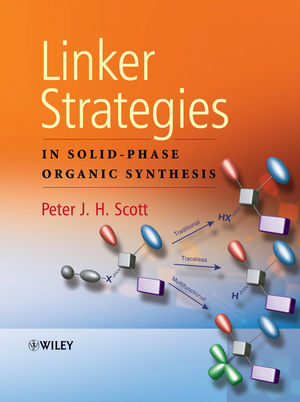Linker Strategies in Solid-Phase Organic SynthesisISBN: 978-0-470-51116-9
Hardcover
706 pages
December 2009
 |
||||||
Preface.
List of Contributors.
About the Editor.
Abbreviations.
I: INTRODUCTION.
Chapter 1: General Introduction (Scott L. Dax).
1.1 Introduction, Background and Pivotal Discoveries.
1.2 Fundamentals of Conducting Solid-Phase Organic Chemistry.
1.3 Concluding Comments.
1.4 Personal Perspective and Testimony: Solid-phase Mannich Chemistry.
1.5 References.
II: TRADITIONAL LINKER UNITS FOR SOLID-PHASE ORGANIC SYNTHESIS.
Chapter 2: Electrophile Cleavable Linker Units (Michio Kuruso).
2.1 Introduction.
2.2 Resins for use with Electrophilic Linkers.
2.3 Electrophile Cleavable Linkers.
2.4 Conclusion.
References.
Chapter 3: Nucleophile Cleavable Linker Units (Andrea Porcheddu and Giampaolo Giacomelli).
3.1 Introduction.
3.2 Linker Units.
3.3 Nucleophilic Labile Linker Units.
3.4 Conclusion.
References.
Chapter 4: Cyclative Cleavage as a Solid-Phase Strategy (A. Ganesan).
4.1 Introduction.
4.2 C-N bond formation.
4.3 C-O bond formation.
4.4 C-C bond formation.
4.5 Conclusion.
References.
Chapter 5: Photolabile Linker Units (Christian Bochet and Sébastien Mercier).
5.1 Introduction.
5.2 Linkers Based on the Ortho-Nitrobenzyloxy Function.
5.3 Linkers Based on the Ortho-Nitrobenzylamino Function.
5.4 Linkers Based on the α–Substituted Ortho-Nitrobenzyl Group.
5.5 Linkers Based on the Ortho-Nitroveratryl Group.
5.6 Linkers Based on the Phenacyl Group.
5.7 Linkers Based on the Para-Methoxyphenacyl Group.
5.8 Linkers Based on the Benzoin Group.
5.9 Linkers Based on the Pivaloyl Group.
5.10 Traceless Linkers.
5.11 Other Types of Photolabile Linker Units.
5.12 Conclusion.
References.
Chapter 6: Safety-Catch Linker Units (Sylvain Lebreton and Marcel Pátek).
6.1 Introduction.
6.2 Activation of a carbonyl group by the inductive effect (I-) of an adjacent substituent.
6.3 Activation by the mesomeric effect (M-) of the X–Y=Z moiety adjacent to a carbonyl group.
6.4 Activation by the positive mesomeric effect (M+) of the -X-Y=Z moiety adjacent to a N-acyl or O-alkyl group.
6.5 Aromatic SNAr substitution.
6.6 Fragmentation by β-elimination.
6.7 Safety-catch linker for release in aqueous buffers.
6.8 Photochemical activation.
6.9 Miscellaneous safety-catch linkers.
6.10 Conclusion.
6.11 References.
Chapter 7: Enzyme Cleavable Linker Units (Mallesham Bejugam and Sabine L. Flitsch).
7.1 Introduction.
7.2 Enzyme Cleavable Linker Units.
7.3 Conclusion.
References.
III: MULTIFUNCTIONAL LINKER UNITS FOR DIVERSITY-ORIENTED SYNTHESIS.
Chapter 8: An Introduction to Diversity-Oriented Synthesis (Richard J. Spandl, Gemma L. Thomas, Monica Diaz-Gavilan, Kieron M. G. O'Connell and David R. Spring).
8.1 Introduction.
8.3 Sources of Skeletally Diverse Small Molecules.
8.4 Enriching Chemical Space Using DOS.
8.5 The Subjective Nature of ‘Diversity’.
8.6 Differing Strategies Towards Similar Goals.
8.7 Generating Skeletal Diversity.
8.8 DOS and Solid-Phase Organic Synthesis.
References.
Chapter 9: T1 and T2 – Versatile Triazene Linker Groups (Kerstin Knepper and Robert E. Ziegert).
9.1 Introduction.
9.2 The T1 Linker.
9.3 The T2 Linker Units.
9.4 Miscellaneous Triazene Linkers.
9.5 Conclusion.
9.6 References.
Chapter 10: Hydrazone Linker Units (Ryszard Lazny).
10.1 Introduction.
10.2 Hydrazone Linker Units.
10.3 Conclusion.
References.
Chapter 11: Benzotriazole Linker Units (Daniel K. Whelligan).
11.1 Introduction.
11.2 Syntheses of Polymer-Supported Benzotriazoles.
11.3 Polymer-Supported Benzotriazole Linked Reactions.
References.
Chapter 12: Diversity Cleavage Strategies from Phosphorus Linkers (Patrick G. Steel and Tom M. Woods).
12.1 Introduction.
12.2 Diversity Cleavage through olefination reactions.
12.3 Diversity cleavage of enol phosphonates through palladium catalysed cross-coupling reactions.
12.4 Oxidative diversity cleavage of cyanophosphoranes.
References.
Chapter 13: Sulfur Linker Units (Peter J. H. Scott).
13.1 Introduction.
13.2 Sulfide Linker Units.
13.3 Sulfonium Linker Units.
13.4 Sulfoxide Linker Units.
13.5 Sulfone Linker Units.
13.6 Sulfonate Ester Linker Units.
13.7 Sulfamate Linker Units.
13.8 Thioester Linker Units.
13.9 Conclusions.
References.
Chapter 14: Selenium- and Tellurium-Based Linker Units (Tracy Yuen Sze But and Patrick H. Toy).
14.1 Introduction.
14.2 Selenium- and Tellurium-Based Linker Group Reagents and Their Syntheses.
14.3 Selenium-Based Linker Group Attachment Methods.
14.4 Selenium-Based Linker Group Cleavage Methods.
14.5 Conclusions.
References.
Chapter 15: Linker Units Cleaved by Radical Processes: Cleavage of Carbon-Sulfur, -Selenium, -Tellurium, -Oxygen, -Nitrogen and -Carbon Linkers (Giuditta Guazzelli, Marc Miller and David J. Procter).
15.1 Introduction.
15.2 Linkers cleaved using tin hydride, alkyltin and silicon hydride reagents.
15.3 Linkers cleaved by oxidative electron-transfer.
15.4 Linkers cleaved by reductive electron-transfer.
15.5 Radical processes that indirectly trigger linker cleavage.
15.6 Conclusions.
References.
Chapter 16: Silicon and Germanium Linker Units (Alan C. Spivey and Christopher M. Diaper).
16.1Introduction.
16.2 Silicon-based Linkers.
16.3 Germanium-based Linkers.
16.4 Conclusions.
References.
Chapter 17: Boron and Stannane Linker Units (Peter J.H. Scott).
17.1 Introduction.
17.2 Organostannane Linker Units.
17.3 Organoboron Linker Units.
17.4 Conclusion.
References.
Chapter 18: Bismuth Linker Units (Peter J.H Scott).
18.1 Introduction.
18.2 Bismuth Linker Units.
18.3 Conclusion.
References.
Chapter 19: Transition Metal Carbonyl Linker Units (Susan E. Gibson and Amol A. Walke).
19.1 Introduction.
19.2 Chromium carbonyl linker units.
19.3 Cobalt carbonyl linker units.
19.4 Manganese carbonyl linker units.
19.5 Conclusion.
References.
Chapter 20: Linkers Releasing Olefins or Cycloolefins by Ring Closing Metathesis (Jan H. van Maarseveen).
20.1 Introduction.
20.2 Cycloolefins via method I.
20.3 Terminal olefins via route II.
20.4 Terminal and internal olefins via route III.
20.5 Conclusion.
References.
PART 4: ALTERNATIVE LINKER STRATEGIES.
Chapter 21: Fluorous Linker Units (Wei Zhang).
21.1 Introduction.
21.2 Fluorous linkers for synthesis of small molecules.
21.3 Fluorous linkers for synthesis of biomolecules.
21.4 Other applications of fluorous linkers.
21.5 Conclusion.
References.
Chapter 22: Solid-Phase Radiochemistry (Brian G. Hockley, Peter J. H. Scott and Michael R. Kilbourn).
22.1 Introduction.
22.2 Solid-Phase Surrogates in Radiochemistry.
22.3 Solid-Phase Radiochemistry.
22.4 Conclusions and Perspectives.
References.
PART 5: LINKER SELECTION TABLES.
Chapter 23: Linker Selection Tables (Peter J.H. Scott).
23.1 Introduction.
23.2 Linkers for Alcohols, Phenols and Diols.
23.3 Linkers for Carboxylic Acids, Esters and Related Compounds.
23.4 Linkers for Aldehydes, Ketones and Related Carbonyl Compounds.
23.5 Linkers for Amides, Ureas and Related Compounds.
23.6 Linkers for Amines.
23.7 Linkers Thiols, Thioethers and Disulfides.
23.8 Linkers for Sugars.
23.9 Linkers Liberating Alkyl Groups.
23.10 Linkers for Alkenes, Alkynes and Related Compounds.
23.11 Linkers for Aryl Compounds.
Index.



